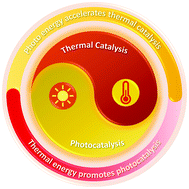Thermo-photo catalysis: a whole greater than the sum of its parts
Abstract
Thermo-photo catalysis, which is the catalysis with the participation of both thermal and photo energies, not only reduces the large energy consumption of thermal catalysis but also addresses the low efficiency of photocatalysis. As a whole greater than the sum of its parts, thermo-photo catalysis has been proven as an effective and promising technology to drive chemical reactions. In this review, we first clarify the definition (beyond photo-thermal catalysis and plasmonic catalysis), classification, and principles of thermo-photo catalysis and then reveal its superiority over individual thermal catalysis and photocatalysis. After elucidating the design principles and strategies toward highly efficient thermo-photo catalytic systems, an ample discussion on the synergetic effects of thermal and photo energies is provided from two perspectives, namely, the promotion of photocatalysis by thermal energy and the promotion of thermal catalysis by photo energy. Subsequently, state-of-the-art techniques applied to explore thermo-photo catalytic mechanisms are reviewed, followed by a summary on the broad applications of thermo-photo catalysis and its energy management toward industrialization. In the end, current challenges and potential research directions related to thermo-photo catalysis are outlined.



 Please wait while we load your content...
Please wait while we load your content...